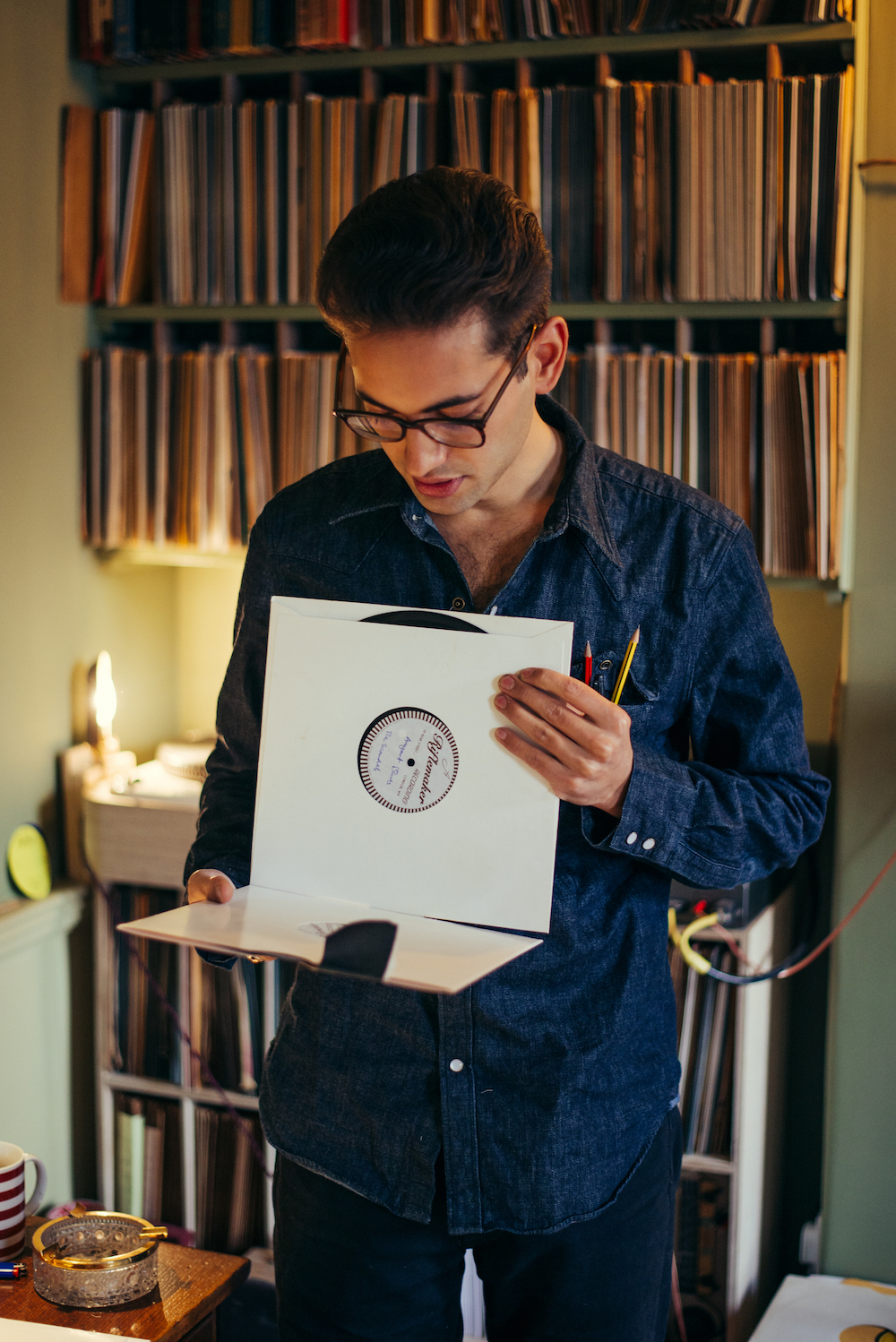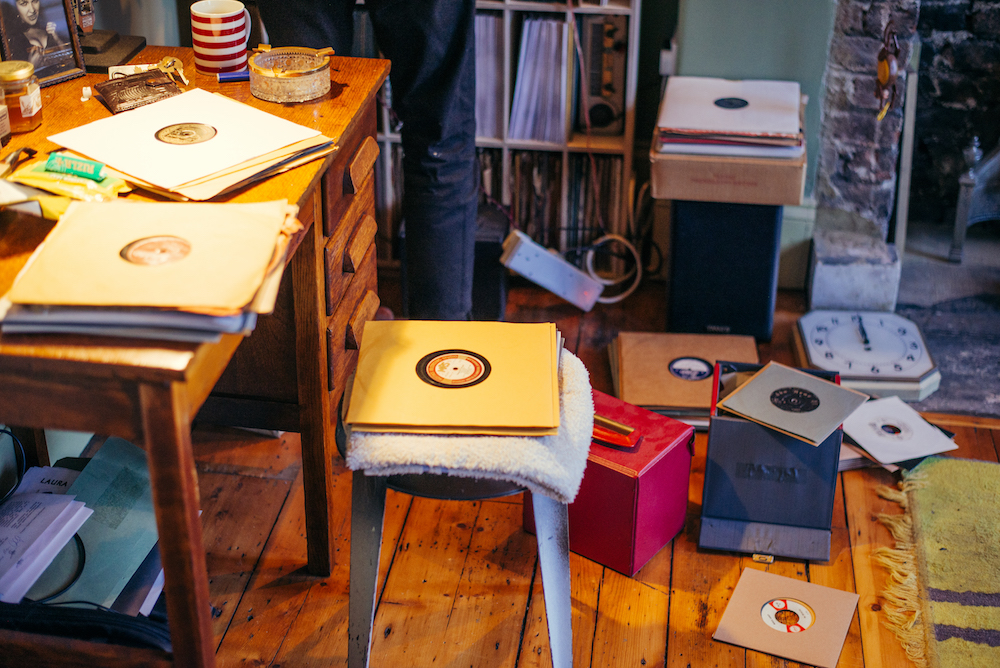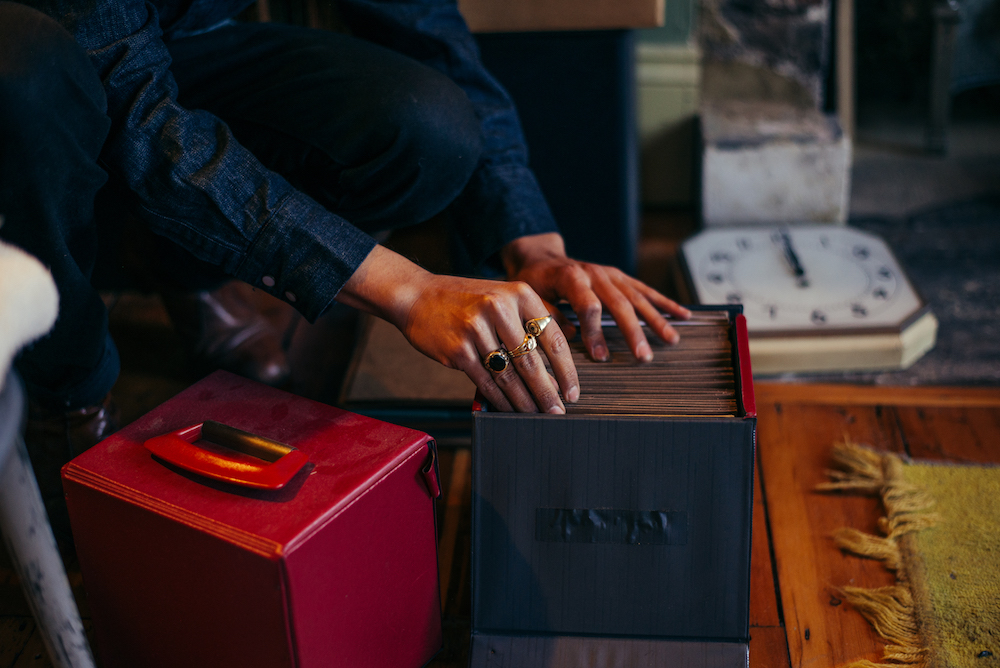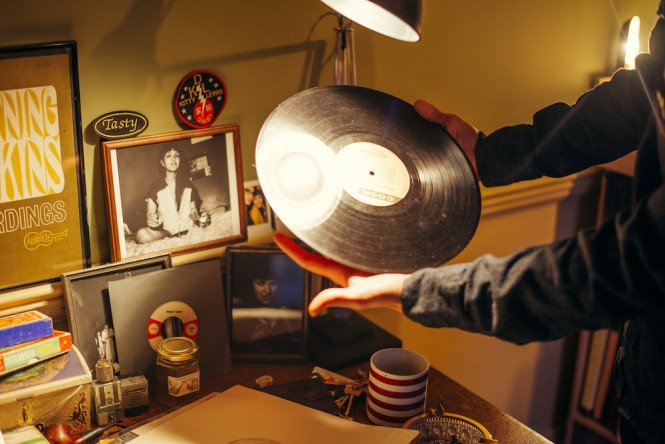Published on
February 5, 2016
Category
Features

Our Crate Diggers series profiles record collectors around the world. Following UK bass maverick Andrea Parker, we meet 78rpm and blues enthusiast Lewis Durham of Kitty, Daisy & Lewis.
Fronted by three siblings, Kitty, Daisy & Lewis’ music references R&B, swing, blues, country and rock ‘n’ roll. Their fascination with golden era, analogue sound has even taken them to release singles on 78s.
Growing up in a musical household with a punk mother and a recording engineer father, middle child Lewis bought his first lathe aged 14 and began cutting dubplates for his sister’s mates in the UK garage scene. Now on to a Scully lathe and surrounded by stacks of vintage valve gear, it stands to reason his record collection would be out of the ordinary.
We spent an afternoon at his North London HQ having a chat and a snoop around.
Interview: Amar Ediriwira / Photography: Michael Wilkin
Let’s start with your family and upbringing. Obviously you’re in a band with your sisters, but I hear your parents worked in music?
My mum was the drummer in The Raincoats. Not for long though, she got kicked out for some reason, I don’t know why. Pretty punk getting kicked out of a punk band if you ask me…
Probably as punk as it gets!
Totally, but you wouldn’t really realise today if you met her and that was before I was born. My dad worked in the mastering division of Island Records, which was over in Chiswick at the time. My mum was going out with someone in a band that went to my dad’s studio to have a record cut. That’s where they [my parents] met, and here I am!
You must have been swimming in records growing up.
Well my dad had records but he didn’t really play them. Because he worked in the studio all day, when he came home he didn’t want anything to do with it. But he used to sing to us with a guitar. He’s from India and that’s what his family did there. My mum would play us her records, stuff like Kinks, T-Rex and all that. At home we only had records and a cassette machine so seeing records was completely normal, that’s how we listened to music.
Like you, I was born in 1990 but I was pretty much raised on CDs, maybe the odd tape.
I think because my mum had always bought records, when CDs came out she didn’t really think about replacing them, she just kept her vinyl. We were exposed to contemporary music just as much as any other kids, like my sister was into the Spice Girls and UK garage.
I never really took to current msuic or what my mates were listening to. Actually… that’s not completely true, they listened to lots of different things and I would play them music as well. When they’d come round to my house, I’d put on records.
What sort of thing were you listening to back then?
Blues. I loved blues and I still do. Also, West Indian music, ska and calypso. Obviously rhythm and blues. For example, T-Bone Walker’s ‘News For My Baby’ is a record I got when I was quite young. It was mostly black music I bought. It was people like Johnny Cash and Jerry Lee Lewis who initially grabbed me and then I found their influences. Even now, I like certain songs by those guys but if I go to a pile of records they’re not the ones I go for first. It’s usually the Muddy Waters and the Howlin’ Wolf records.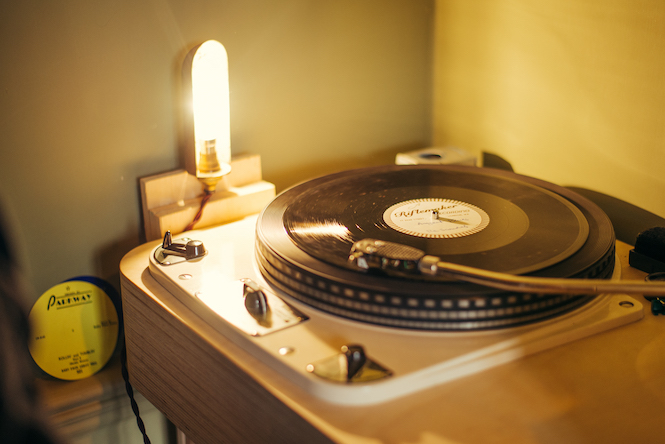
Is there one especially formative record from your childhood?
It was probably something completely different actually. The one that springs to mind is a record called ‘A Swingin’ Safari’ by the German composer Bert Kaempfert. That’s one that we always loved as kids but were never allowed to play because we had this Shure V15 that was very fragile.
I like your turntable. Is it custom-built?
My uncle found this, dumped out the back of an auction home. It’s a Garrard 301 transcription motor which was pretty much the highest grade turntable you buy in the UK at the time. They didn’t come with an arm, it was literally just the table and you had to make the rest (plinth, arm mounting…) The arm I got was originally a 9″ SME but I modified it to 12″.
What’s the idea with longer tonearms?
Because of groove geometry, you get what’s called a tracking error. So a record is cut straight but an arm curves when you play because the stylus isn’t going straight across the disc. The longer the arm, then the less of tracking distortion.
Downstairs in the studio, where you record with the band, you’ve got tonnes of old valve gear and a Scully cutting lathe. When did your obsession with analogue begin?
I remember my granddad had a gramophone, which he’d wind it up and play records on. I was obsessed with it. When you’re a kid, you’re like how the fuck does that work? I became interested in mechanics and electronic engineering and then I managed to get a little disc cutting system when I was in Year 9. I set it up in my bedroom and made records for people in my sister’s year who were MC’ing. They’d give me the CD and I’d cut them a disc.
Scroll through the gallery below:
Cutting dubplates aged 14 is pretty good going! Did you learn from your dad?
Yeah kind of, but it’s also common sense, you know, trial and error. You do a cut and you notice that it sounds shit or that it’s noisy and you take it from there. It’s all very mechanical. In fact the mastering bit is probably the easiest part of making a record. People say ‘dark art’ and all that but the actual mechanics and physics of it is very understandable and logical, once you can understand that, you can begin to realize the capability’s and limitations of disc recording.
I read that it’s been a bit of a dream of yours to release your output with Daisy, Kitty & Lewis on 78. Did you manage to do it? Getting a 78 pressed up can’t be easy…
Yeah we did it. I had to do a bunch of things to make it happen. If you look at a normal record, you’ll see that it isn’t flat, which is actually really shit, but that’s the way records are made because it presses quicker (due to less non-fill at quicker pressing speeds). It’s just an economics thing and that’s become standard practice.
In the 78 era they never used to do that – there’s no groove guard and the record doesn’t come up on the edge. To have that done now you need to use special moulds, which are flat and take longer to press. The plant has to have them made, but they’re expensive so they’ll only do it if there are other people who want in. Luckily when we wanted to press up our stuff, they had just made a test disc for someone who had done loads of classical music.
Did I also read that you bought a pressing machine?
That’s a sad story, it’s a bit of a soft spot. I tried to buy a press from a guy in Florida and the bastard took my money and shafted me. Back then they were like scrap metal, now prices have shot up. He probably did me a favour though. What am I going to do with one of those machines?! I guess, the idea was to do every step of the process but the pressing thing is a whole other world. I could never do the galvanics and all that.
 Looking at your collection, your records appear to be neatly filed by format. Are they also organised by genre?
Looking at your collection, your records appear to be neatly filed by format. Are they also organised by genre?
Yeah. Most of the left hand side is 78s. These shelves are jazz – [pointing out sections] this is the good jazz, this is the okay stuff and at the bottom is 10″ LPs. All of that is blues, R&B, West Indian and that corner up there is miscellaneous, I don’t know where to put those records! That top shelf is 78 albums. Then over on the right we’ve got 7″s and LPs, mainly jazz.
I actually only recently moved to this place so I decided before I put them all away to try to sort them out alphabetically. I did it by artist but then lots of artists, especially in the blues world, went under different names for different records. So there’s the question of whether to group them together or not. In the end I just thought, fuck it I’m wasting my time here.
When you look at your collection, particularly the 78s, it’s easy to label you a collector. Was it that you consciously started collecting or did you realise one day that you had amassed a load of records?
With 78s, you can’t just go to a shop and dig through crates and find this stuff. So it was a case of thinking, I want that, and searching it out. And then when you’re there looking through a specialist box, you might stumble across other bits. Obviously with the LPs you can just casually shop for it, but I only have about one and a half rows of LPs. I got rid of a load of stuff that I didn’t want.
So you’re not a hoarder.
No, I’m not a hoarder. Laura, my girlfriend, won’t agree with that but…
Can you explain the appeal of a 78?
When I was a kid, they felt heavier, more material per song if you like. Also I’ve always enjoyed the single format. I’ll only play an LP if I’m cleaning up or whatever. I rarely do that though, I usually put on a single and listen to it and then take it off and find another one. I like chopping and changing really quick, like an auto changer, where you could stack records to make your own album, kind of like a mixtape.
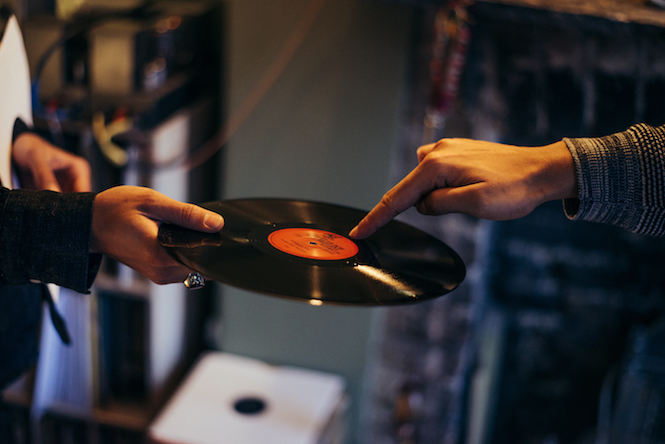
Have you had any weird encounters when hunting for 78s?
I once went to a place called R&B records in Philadelphia, owned by a guy called Val Shively. The shop is tiny but behind it is this huge three-storey warehouse where you can’t go unless you’re after something specific. I went in and he said, “What the fuck do you want?” I told him the name of the R&B record I was looking for and he let me have a look around. And just then this guy comes in and asks for records by Muse. Val literally turned into Satan; picked up a record, didn’t even look at what it was, and frisbee’d it at this guy. It went smash into his head and he told him to get the fuck out.
That’s like a character straight out of High Fidelity.
Yeah none of that health and safety bollocks. I had to buy something, in case he locked me up or something.
78s tended to be recorded in a single take right?
Yeah, it generally was a one take thing. That’s pretty much how it was done in the 1960s as well. If you listen to early Stones or whatever it’s just them playing one take.
Do you find that appealing?
I do, but I don’t think it’s better or worse because I also love records made in completely the opposite way, with tonnes of processing. Some of the glam records for example couldn’t have been done without the studio techniques. Stevie Wonder was big on that too.
Scroll through the gallery below:
Do you have to take extra care with 78s?
Sometimes you see people flicking through records fast in a crate; you can’t do that with 78s. They’re very brittle and tend to break easily, but that said, there are loads of different compositions for the records, depending on the era. For example during the war, they used less shellac because you couldn’t get it so readily; instead they used more filler which is why those records are generally noisier.
Shellac isn’t the main ingredient actually, there’s slate and carbon black and loads of things in there. The later ones have vinyl in them and tend to be quieter. Different labels spent different amounts of money on pressings and so some labels sound like crap and some sound great.
Play us something with an interesting pressing.
This is Blind Willie Johnson’s ‘Keep Your Lamp Trimmed And Burning’ from 1928. It’s on Columbia 1400 series and at this point, they’d just gone over to electrical recording. There’s no run-in groove so the music just starts. The pressing is probably as thick as a ’50s record and because people were playing them on acoustic machines, which they shouldn’t have been doing, a lot of them are messed up now. This one’s actually in quite good condition but it’s still kind of noisy compared to a later disc. The surface noise is almost at the same level as the music.
Whereas take this Lightning Hopkins record. It has a completely different formula, probably with vinyl in it, which is why it’s a lot clearer to listen to surface noise wise. The disc is also cut at louder level which brings the signal to noise ratio down.
Do you own any ‘holy grails’?
Only broken ones! You can glue them back together you see. That’s how I used to get expensive records: I’d go to dealers/collectors and ask for their broken records. If you’ve got both pieces, then you can glue it back together. What you do is hollow out the cracked edges on each side, get a sheet of glass (because it’s flat as a witch’s tit), you put glue in the middle and you clamp it together. Some of them go kind of crumbly though and are unfixable.
More generally with holy grails though, I don’t really have that kind of stuff because it’s just too expensive. I have found certain good things from time to time, like Muddy Water’s first record ‘Train Fare Home’, which I found in a stack of country records. It wasn’t in the best of nick but that was exciting.
What’s the most you’ve dropped on a record?
£300. It was Otis Spann’s ‘Must Have Been The Devil’. I first heard Gaz Mayall play it at his club Gaz’s Rockin Blues when I was a kid and had to have it so I saved up for months. I’ll never get rid of it but the price of a record has never interested me, if something is worth more, it doesn’t make me want it more. Some of my favorite sides.
I got a lot of stuff from swapping with people or I’d recondition someone’s turntable and get a record in return, which is only two songs!
Do you know many other 78 collectors?
There’s a few around I know. There are people who collect 78s for the format, which I don’t get. Why would you like the music just because of the format that it’s on? And then there are people who are into the music and because of that they buy the format, which I guess I fall under. Although I don’t really buy much any more because there’s so much here I could listen for the rest of my life.
You should probably play some more from the collection then!
I like calypso music. Let’s see what might be good to play… [searching for a record]. 78s aren’t very good for entertaining guests are they? Just give me an hour and I’ll be with you!
How about this Lord Kitchener record ‘Saxophone Calypso’ from the ’40s? It’s one of his most famous ones and the lyrics are risqué. It’s a sort of pop, party record, aimed at people who had migrated here from the West Indies incase they felt homesick or whatever.
Kitchener had his own style, but if we go earlier to the ’30s you get the more traditional Trinidadian stuff. For example this one by Atilla the Hun, with lots of strings and more of a political message.
Do you buy contemporary music on vinyl?
Not really. There’s a few people I like out there, like a good friend of mine Michael Kiwanuka. I bought his record but usually I don’t because I can hear it in other ways, like YouTube and streaming.
I like that you’re willing to get out your most delicate records out and put them on the deck. What’s the point in having them if you don’t play them?
Totally. Some people spend £10,000 on a disc and won’t play it. They’ll just get it out for shit like this when the camera comes and pose with it! I don’t get that at all. I like talking about the music. If there’s a party, I’ll take them out. Even if one got broke at least it was giving enjoyment, that’s what they’re there for.
It’s actually greedy to have records sitting on a shelf when someone could be listening and getting down to it. Most people spend more time getting new records than actually listening to them. I’m not any better because it’s hard to find the time to actually sit down. Life is so busy…







